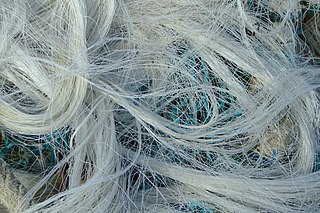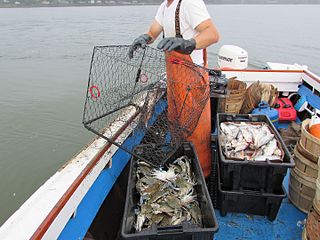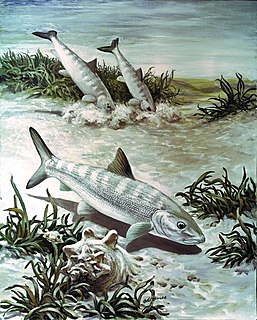Related Research Articles

Trolling is a method of fishing where one or more fishing lines, baited with lures or bait fish, are drawn through the water. This may be behind a moving boat, or by slowly winding the line in when fishing from a static position, or even sweeping the line from side-to-side, e.g. when fishing from a jetty. Trolling is used to catch pelagic fish such as salmon, mackerel and kingfish.

Fly fishing is an angling method that uses a light-weight lure—called an artificial fly—to catch fish. The fly is cast using a fly rod, reel, and specialized weighted line. The light weight requires casting techniques significantly different from other forms of casting. The flies may resemble natural invertebrates, bait-fish, or other food organisms.

Angling is a fishing technique that uses a fish hook or "angle" attached to a fishing line to tether individual fish in the mouth. The fishing line is usually manipulated via a fishing rod, although rodless techniques such as handlining and longlining also exist. Modern angling rods are usually fitted with a reel that functions as a cranking device for storing, retrieving and releasing out the line, although Tenkara fishing and cane pole fishing are two rod-angling methods that do not use any reel. The hook itself can be additionally weighted with a dense tackle called a sinker, and is typically dressed with an appetizing bait to attract the fish and enticing it into swallowing the hook, but sometimes an inedible fake bait with multiple attached hooks is used instead of a single hook with edible bait. A bite indicator, such as a float or a quiver tip, is often used to relay underwater status of the hook to the surface.

A fishing lure is a broad type of artificial fishing baits used in angling that are designed to mimic prey animal and attract the attention of predatory fish, using appearances, movements, vibrations, bright reflections and flashy colors to appeal to the fish's predation instinct and entice it into striking.

Monofilament fishing line is fishing line made from a single fiber of plastic material, as opposed to multifilament or braided fishing lines constructed from multiple strands of fibers. Most fishing lines are now nylon monofilament because they are cheap to produce and can be produced in a range of diameters which have different tensile strengths. Monofilament line is also manufactured in different colors, such as clear, white, green, blue, red, and fluorescent.

Fly tying is the process of producing an artificial fly used by fly fishing anglers to catch fish. Fly tying is a manual process done by a single individual using hand tools and a variety of natural and manmade materials that are attached to a hook. Although the recent history of fly tying dates from the middle 1800s, fly tyers were engaged in tying flys since at least 200 AD.

The Muddler Minnow is a popular and versatile artificial fly of the streamer type used in fly fishing and fly tying.

A spinnerbait or spinner is any one of a family of hybrid fishing lures that combines the designs of a swimbait with one or more spoon lure blades. Spinnerbaits get the name from the action of the metallic blades, which passively revolve around the attachment point like a spinning propeller when the lure is in motion, creating varying degrees of vibration and flashing that mimic small fish or other preys of interest to large predatory fishes. The two most popular types of spinnerbaits are the in-line spinner and safety pin spinnerbait, though others such as the tail spinner also exist. Spinnerbaits are used principally for catching freshwater fishes such as perch, pike and bass.

Plugs are a popular type of hard-bodied fishing lure. They are widely known by a number of other names depending on the country and region. Such names include crankbait, wobbler, minnow, shallow-diver and deep-diver. The term minnow is usually used for long, slender, lures that imitate baitfish, while the term plug is usually used for shorter, deeper-bodied lures which imitate deeper-bodied fish, frogs and other prey. Shallow-diver and deep-diver refer to the diving capabilities of the lure, which depends on the size and angle of the lip, and lure buoyancy.

An artificial fly or fly lure is a type of fishing lure, usually used in the sport of fly fishing. In general, artificial flies are an imitation of aquatic insects that are natural food of the target fish species the fly fishers try to catch. Artificial flies are constructed by fly tying, in which furs, feathers, thread or any of very many other materials are tied onto a fish hook.
Zara Spook 9260 (1939–present) is a topwater type fishing lure. The lure is cast out and retrieved in a "walk the dog" fashion. It is supposed to mimic an injured fish and comes in many different fashions but the most prominent is the minnow type. Any fish that takes its prey from the water's surface would be considered a targeted species with this lure.

Fishing techniques are methods for catching fish. The term may also be applied to methods for catching other aquatic animals such as molluscs and edible marine invertebrates.
This page is a list of fishing topics.
The following outline is provided as an overview of and topical guide to fishing:

Louis John Rhead was an English-born American artist, illustrator, author and angler who was born in Etruria, Staffordshire, England. He emigrated to the United States at the age of twenty-four.
This is a glossary of terms used in fisheries, fisheries management and fisheries science.

Crab traps are used to bait, lure, and catch crabs for commercial or recreational use. Crabbing or crab fishing is the recreational hobby and commercial occupation of fishing for crabs. Different types of traps are used depending on the type of crab being fished for, geographic location, and personal preference.

Bonefish fly patterns are a collection of artificial flies routinely used by fly anglers targeting various species of Bonefish. Bonefish frequent tidal sand and mudflats in tropical and sub-tropical latitudes to feed on benthic worms, fry, crustaceans, and mollusks. Bonefish have small mouths and most Bonefish flies are tied on size 4 to 8 saltwater fly hooks.
References
- Luckey, Carl F. Old Fishing Lures and Tackle 6th Edition, Iola Wisconsin, 2002. (Pages 249–314).

